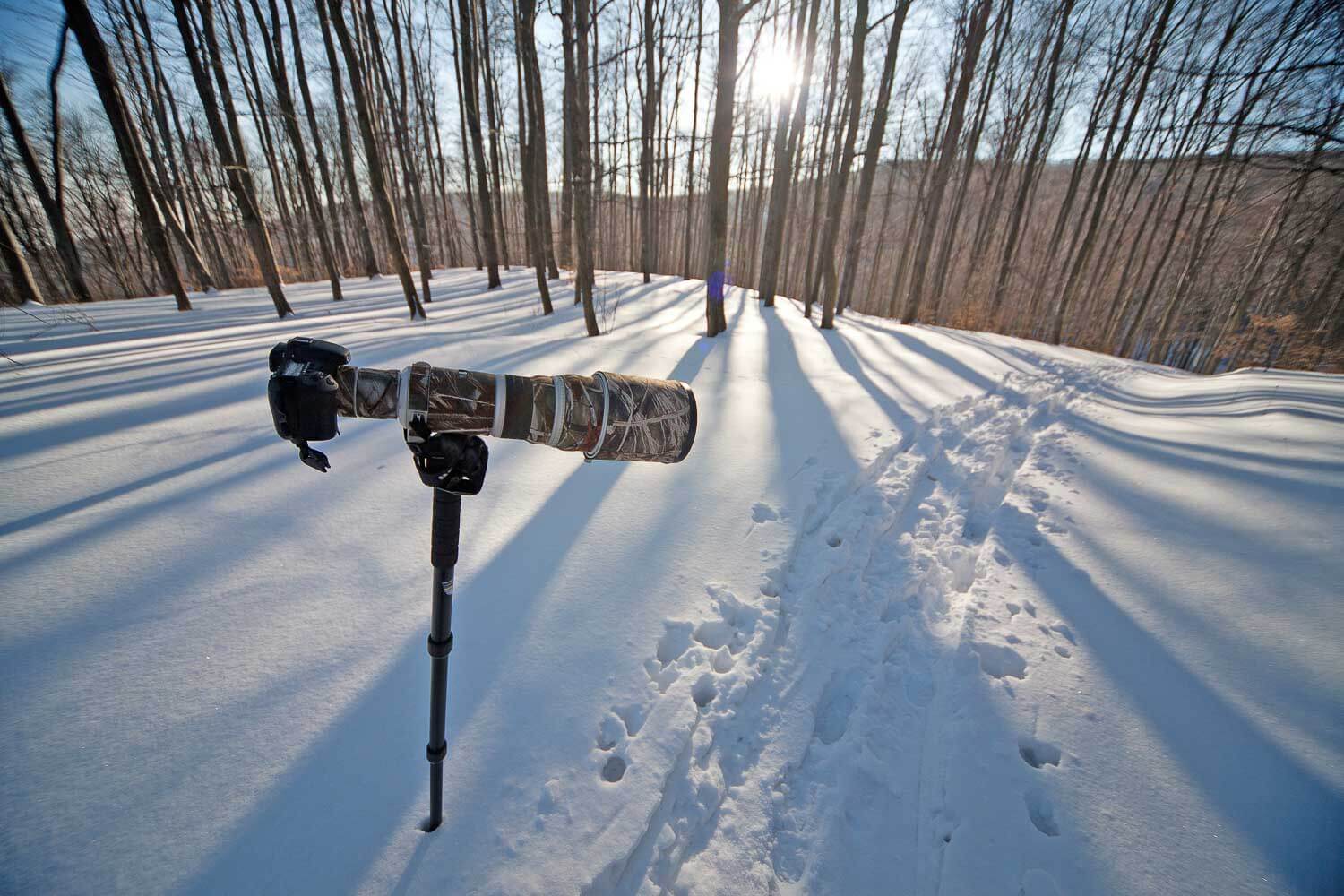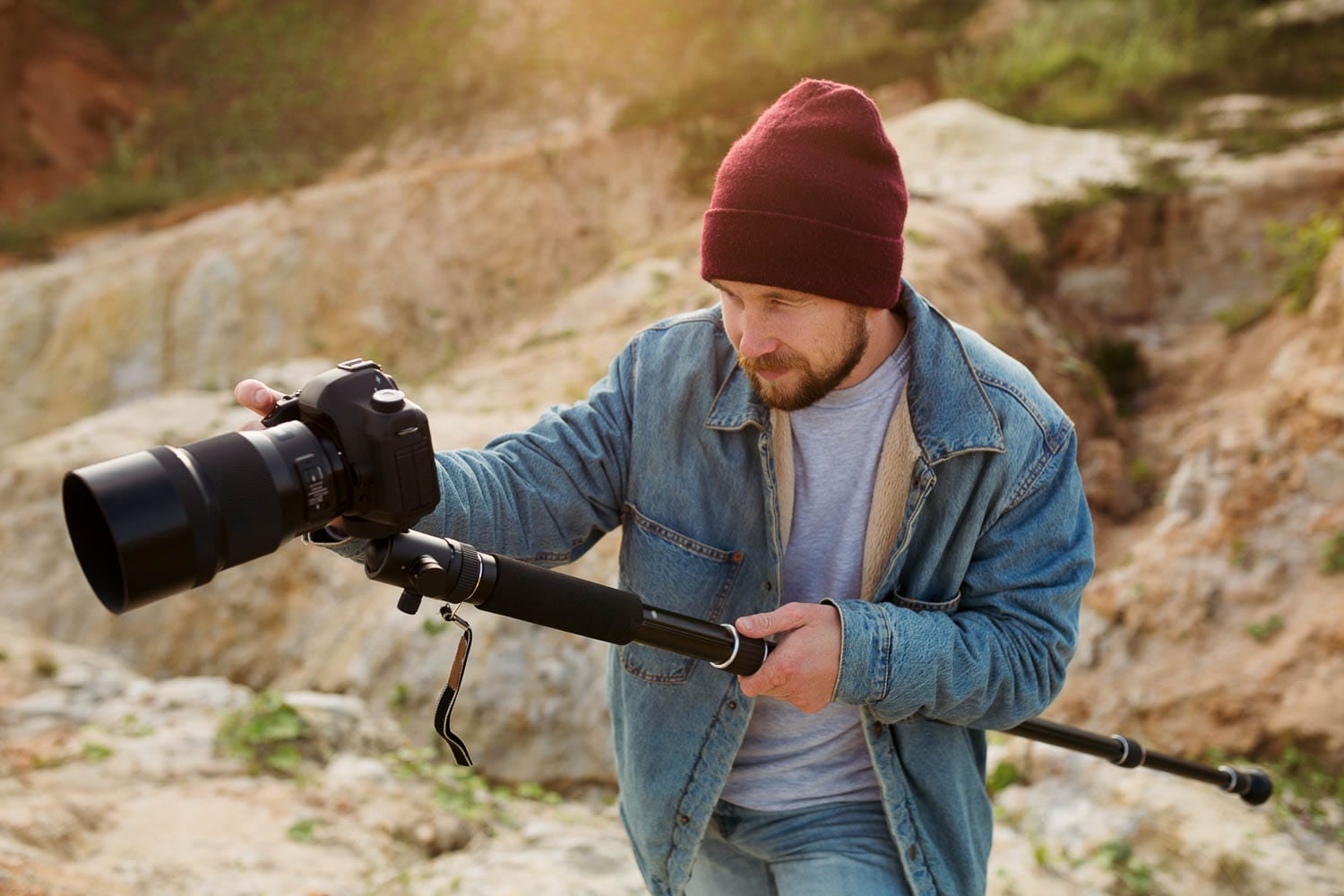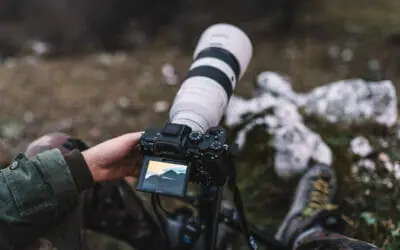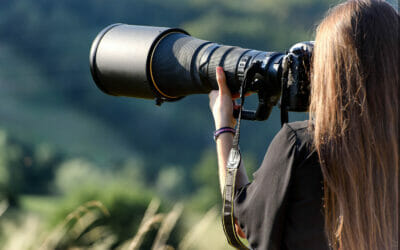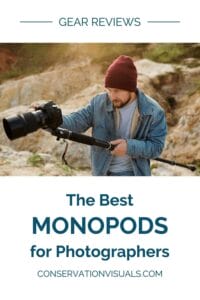In the world of wildlife photography, having the right gear is as critical as having a keen eye for those fleeting shots. One essential piece of equipment is a good camera monopod that'll help reduce blurry photos and capture sharp shots of wildlife.
Lightweight and easy to maneuver, a monopod can hold your camera gear steady when the right moment appears before you. While both monopods and tripods are critical to achieving a steadier shot, as wildlife photographers we often find ourselves hiking deep into the remote habitat's of our wild friends, preferring lightweight monopods to their heftier tripod cousins.
At the same, we need a platform that's strong enough to hold our heaviest camera setup and that's why not just any camera monopod will do.
That's why we've done the research and the testing, and come out the other side with recommendations to help you pick the best monopod for wildlife photography!
Our picks at a glance
Why use a monopod for wildlife photography
Here's the thing: in-camera image stabilization can do a lot. But sometimes, especially when you're out there in the field lugging around heavy gear and zeroing in on a frame hand-held, your hands are going to get tired. With that comes camera shake that can be a bit much for image stabilization alone.
With a camera monopod, your hands get a break and you get added vibration reduction. This extra stability becomes extra important at lower ISO settings and slower shutter speeds.
By providing that extra bit of stability, a monopod allows you to dial down the ISO setting, ensuring your photos retain their quality with minimal noise. With slower shutter speeds, the risk of camera shake is magnified, enhancing the need for a great monopod that'll help reduce camera shake.
A monopod offers just enough support to mitigate these shakes, yet provides the freedom to pivot and follow the action!
Photo: Olga Gavrilova/Shutterstock
How we picked the best monopods for nature and wildlife photography
We at Conservation Visual Storytellers Academy have extensive experience in nature and wildlife photography. Our writers and editors use the major brands available and have decades of experience in the field.
To choose the best recommendations for you, we combine personal experience, insights from fellow pros and industry experts, editorial and user reviews, and details from manufacturers. We carefully weigh the pros and cons of each item and put only what we feel is the best selection available into our recommendation guides.
We've curated a selection of different monopods to meet the needs of different photography goals and budgets.
Factors we consider include weight capacity, versatility, durability, portability, and more that help you find the right camera monopod for wildlife photography.
For advice on what to consider in a wildlife photography monopod and how to choose the right one for you, use the table of contents to jump to those sections.
Our Reviews & Recommendations
Benro SupaDupa Monopod
- Exceptional value for the features
- Second only to the Trent when it comes height
- Relatively light, particularly when you consider its load bearing capacity
- Twist lock and flip lock combo
- Haven't found a downside yet...
SPECIFICATIONS
- Material: Carbon fiber
- Leg Sections: 6
- Height Range: Up to 64.9″
- Load Capcity: 88 lbs
- Weight: 1.1 lbs
Impressive height? Check. Heavy weight capacity? Check. Twist locks combined with a fast flip lock? Uh, yah.
The name “SupaDupa” makes sense because those key features all packed into just over one pound is, dare I say, super duper.
Sturdy yet lightweight, adjustable and versatile, the MSDPL46C model monopod aims to impress. It comes with a detachable rubber rotating foot, a spiked foot, and a wrist strap for secure handling.
Myself, I don't even crack 5 feet 3 inches, so this size works great for me. But, if you're looking for something taller within the SupaDupa series, check out the MSD46C which extends to over 72″ while still packing down to under 18″.
For the spec's and features, it's hard to find a better value for a monopod.
BEST PRICES
Sirui P-326 6-Section Carbon Fiber Monopod
- Versatile shooting options
- Compact and lightweight design
- Easy to use and setup
- Reasonable price for quality build
- Not the most impressive load capacity, particularly for the weight
SPECIFICATIONS
- Material: Carbon fiber
- Leg Sections: 6
- Height Range: Up to 60.6″
- Load Capcity: 22 lbs
- Weight: 0.9 lbs
WHAT WE THINK
As a professional wildlife photographer, having lightweight, durable equipment that doesn’t compromise on stability is paramount.
Easy to carry (packs up tight and weighing less than 1 lb) with a fast setup speed, the Sirui P-326 is my go-to monopod.
The monopod’s carbon fiber construction not only keeps it feather-light, but also remarkably sturdy. And while it doesn't have the most impressive load capacity on our list, it's good enough to get the job done.
Its height adjustability offers pretty impressive flexibility for shooting from various angles and the twist locks, complemented by a durable silicone design, facilitate a quick and secure setup.
The comfortable foam grip and built-in wrist strap enhance its usability. The reversible screw on the mounting plate provides versatility in attaching different gear, and the rubber foot with a metal spike offers stability on various terrains.
Plus, the price is really reasonable, making this guy an excellent balance of quality, durability, and affordability.
BEST PRICES
Manfrotto Element MII
- Affordable, like so affordable
- Sturdy and durable build
- Packs up small, particularly compared to its max height
- Comfortable hand grip and secure wrist strap
- Heavy relative to what it can hold
SPECIFICATIONS
- Material: Aluminum
- Leg Sections: 5
- Height Range: Up to 62.6″
- Load Capcity: 35 lbs
- Weight: 1.1 lbs
WHAT WE THINK
The Manfrotto Element MII is the only aluminum monopod on our list, and with that – maybe not surprising – it's also the most affordable monopod on our list.
That being said, Manfrotto always impresses and this monopod follows suit.
I was skeptical about its sturdiness, given its price point and my preference for carbon fiber construction, but it holds up remarkably well in various terrains.
With a generous height range that packs up compactly and an impressive weight to load capacity ratio, if you have a preference for aluminum or just want to save a few bucks, we can't recommend this monopod enough.
The monopod's compact design doesn't just add to its portability but also makes storage a breeze. And, including a wrist strap adds that extra layer of security and comfort during extended shoots.
The 5-section leg, featuring ergonomic twist locks, allows for quick and nimble height adjustments—essential when trying to capture fleeting wildlife moments from different perspectives. The dual 1/4″ – 3/8” attachment points offer fantastic versatility, accommodating mounting the camera directly or attaching a head.
Regardless of the price, it stands out as an exceptional tool for wildlife photography demanding a blend of strength and minimalism.
BEST PRICES
Gitzo Series 2 Traveler GM2562T
- Ideal for travel
- Lightweight and compact
- Impressive build quality
- Durable carbon eXact tubing
- Limited height
- Quite pricey
SPECIFICATIONS
- Material: Carbon fiber
- Leg Sections: 6
- Height Range: Up to 55.9″
- Load Capcity: 39 lbs
- Weight: 0.89 lbs
WHAT WE THINK
With a weight limit strong enough to load it with a full frame DSLR and heavy telephoto lens, the Gitzo Series 2 Traveler still somehow manages to be the lightest weight monopod on our list!
While we wouldn't mind seeing a few more inches of height for our taller friends, the height range isn't too bad and it packs down super compactly making transporting it easy peasy.
The 6-section carbon fiber legs secure quickly into place via Gitzo’s signature twist locks and an ergonomic rubber grip provides added comfort and stability.
The anti-leg rotation system makes for quick adjustments without fumbling with multiple locks and the reversible screw on the mounting plate adds versatility in gear attachment.
We love the smart clip on the wrist strap about as much as we love the new design of the stable foot (though we would love it even more if the foot was interchangeable).
At a higher price point than others on our list, if you're looking for top of the line quality, lightweight design, and a sturdy load capacity, this monopod is worth the splurge.
BEST PRICES
3 Legged Thing Punks Trent 2.0
- Reaches such great heights!
- Legit load bearing ability
- Exceptional engineering and design
- Secure and ergonomic locks
- No wrist strap
- Material: Magnesium alloy
- Leg Sections: 4
- Height Range: Up to 79.5″
- Load Capcity: 65 lbs
- Weight: 1.6 lbs
WHAT WE THINK
One of the tallest monopods on the market and the tallest monopod on our list, the 3 Legged Thing Trent 2.0 offers impressive height options. Constructed of magnesium alloy, it's only slightly heavier than its carbon fiber equivalent and is still relatively light weight.
Even when fully extended, it can hold 65 lbs, plus its lateral load capabilities allow use as a boom for cameras or microphones.
The 4-section design with twist locks allows for quick and easy set up, while the new design of the locks offer improved grip and leverage with rubber pads and knurling.
The comfortable foam grip provides a sturdy handhold and the detachable rubber foot adds extra stability with the versatility to replace it with their other foot accessories.
We'd like to see a wrist strap included, but, alas, no one monopod is perfect. And, although not as compact as some other options, its weight to load capacity ratio is impressive for its height range.
If you're looking for maximum height without compromising on stability or weight capacity, this monopod is definitely worth considering.
BEST PRICES
3 Legged Thing Legends Alana Carbon Fibre Monopod
- Mind-blowing load capacity
- Can handle nearly 100x its own weight
- Thoughtful engineering
- Sturdy and durable design
- Its max height is nothing to sneeze at, but if you want something taller, go with the Trent 2.0
SPECIFICATIONS
- Material: Carbon fiber
- Leg Sections: 5
- Height Range: Up to 62.3″
- Load Capcity: 132 lbs
- Weight: 1.4 lbs
WHAT WE THINK
With the highest load capacity of the monopods on our list and still somehow able to pack down small enough to easily fit into luggage or camera bags, 3 Legged Thing designed this piece of equipment for wildlife photographers on the go who are not messing around.
Its lightweight design, coupled with the astonishing 132 lbs weight capacity, means I can confidently perch my hefty lenses atop this sturdy monopod for those patience-testing wildlife stakeouts.
Grippy rubber O-Pads on the leg locks and dual spring-loaded threads are a small detail that speak volumes about the thought put into this monopod's design. Switching between cameras and lenses or adding a head for more dynamic shooting angles is a breeze.
If you need something taller, then you'll probably prefer the Trent 2.0, but other than that aspect, the Alana steals the show.
BEST PRICES
Recommended: Strap that monopod to something comfortable to carry! Here are our recommendations on camera bags for the adventurers: Best Camera Backpacks for Hiking! Or, if you're looking for something with more legs, here are our top recommendations for tripods.
Photo: sondem/Shutterstock
Key monopod features to consider
Monopods are fairly straightforward tools, consisting of a single adjustable pole that extends and retracts to fit your shot and your stature, giving you the flexibility to go low for a ground-level shot or to extend your reach for high angle shots.
Consider the following criteria when choosing the best monopod for you:
❂ Stability
In wildlife photography, we're often handling heavy cameras made heavier by an attached hefty long lens that requires extra stability when taking a shot.
A camera monopod gets its stability not only from the material it's constructed of, but also from reliable locks and secure footing.
Monopod leg sections lock into place using either flip locks or twist locks.
Flip locks are quick, but may require tightening over time; twisting ones aren't as quick to lock-in but don't require maintenance down the road.
At the base of the monopod is a foot, often a rubber foot for a secure grip. Some monopods also come with additional attachments like ball-joint feet or even small tripods to transform your monopod into a hybrid support system.
❂ Load capacity
Whether you're out with lighter mirrorless cameras or heavy camera bodies with an attached super telephoto lens, you need a camera support with a high enough maximum load capacity to handle your camera setup.
Weigh your heaviest camera and lens combination and keep that in mind when choosing the right monopod for you.
❂ Height
Nothing’s worse than a monopod that's too short, leaving you hunched over for far too long. Consider how tall you are and the height range you plan to shoot at.
You'll want to make sure the monopod you opt for reaches the minimum and maximum height that you need within its adjustable height range.
❂ Adjustability
A monopod allows you to quickly set up and adjust, granting you the agility you need. Adjusting your monopod is straightforward – extend the leg to match your eye level, ensuring you don't have to stoop or tiptoe to meet your viewfinder.
Imagine it's an extension of your body, a sort of third leg that's an extension of your vision, enabling you to stay mobile while maintaining focus on your subject.
❂ Portability
The more weight-conscious adventurer will want a monopod that strikes a balance between sturdiness and a low carry weight. A lightweight monopod makes for easy transportation, particularly as a wildlife photographer covering long distances on foot.
Similarly, make sure that the packed length works well with your backpack.
❂ Ergonomics
Below the mounting plate on the column there's a grip, typically either a foam or rubber grip. This is where you hold on – or grip – the monopod to hold it in place and keep it steady while shooting.
Comfortable, ergonomically designed grips and straps let you handle a monopod longer and more steadily.
❂ Materials
Monopods are typically made from carbon fiber, magnesium-alloy, or aluminum. Lightweight and durable carbon fiber is typically my preference.
Photo: MAD.vertise/Shutterstock
Using a monopod vs tripod
As with any type of stabilizing equipment, from monopods to our tripod buddies on three legs, you're going to want something with a maximum payload that'll easily support your lens and camera while providing the added stability you need whether on soft ground or solid rock.
Why not just go with a tripod then?
Well, you can, but tripods are heavier and bulkier, limiting their portability and flexibility when compared to the more mobile and compact monopod. As wildlife photographers, we need to be able to move quickly and set up for a shot fast.
Tripods just can't offer that same flexibility.
A camera monopod supports your gear while keeping you agile and mobile. In outdoor photography, where the unexpected often becomes the norm, choosing between a monopod and a tripod is not just about camera support — it's about how you want to move through the scene and get behind a shot with ease.
Plus, monopods are more affordable, and who doesn't like a bargain, amiright?
Frequently Asked Questions
Are carbon fiber monopods worth the extra cost?
Carbon fiber offers the strength of steel at a fraction of the weight, making it perfect for those long hikes. But, it's all about balancing your budget with your needs.
Can I use a monopod as a walking stick when I'm not shooting?
Many photographers do! Just keep in mind the terrain and the monopod's foot type. Some are better suited for double duty than others.
How do I maintain and clean my monopod?
Keep your monopod in top shape by regularly wiping it down with a damp cloth. Avoid using harsh chemicals or abrasive materials. If the leg locks start to get sticky or loose, use a small amount of silicon lubricant to keep them in good working order. And always check for any wear and tear before heading out on a shoot.
Can I use a monopod for video or only for photography?
Monopods can be used for both photography and videography, depending on the model you choose. Some are specifically designed with features like fluid heads to make shooting smooth videos a breeze.
Do I need a special mount for my monopod?
Most monopods come with a standard 1/4″ or 3/8″ screw that can be used with any tripod head or to fasten your camera directly to the monopod. However, some models may require a specific mount for certain cameras or setups.
Can I use a monopod with a heavy camera and lens setup?
Absolutely! Just be sure to choose a monopod that can support the weight of your gear. Pay attention to the maximum weight capacity listed for each model and consider getting one with a higher capacity than your current setup to account for any future upgrades.
How do I ensure my monopod stays stable on uneven terrain?
Some monopods come with features like spiked feet or removable rubber covers that can provide better grip and stability on different types of surfaces.
You can also look for models with adjustable legs or pivoting feet to help balance on uneven ground or ones that allow you swap out the foot type.
How to choose the best monopod for YOU
When choosing the best monopod for wildlife photography, consider what you'll be shooting most often and the environment you'll be in.
Weight, material, and height range are your basic steps to start with.
Imagine your monopod as an extension of your own being, seamlessly integrating into your photography adventures, blending stability with flexibility.
When you go to pick one, listen to your gut. Sometimes, it's not about all the specifications on paper but about how it feels in your hands. If possible, test a few out or reach out to fellow photographers for their first-hand experiences.

